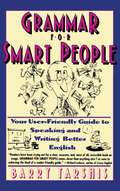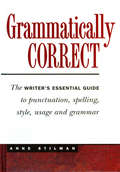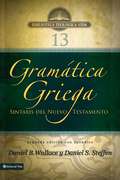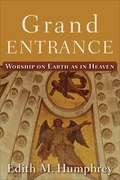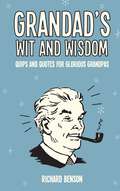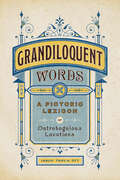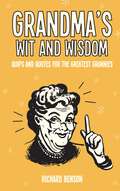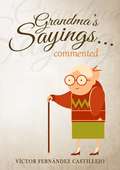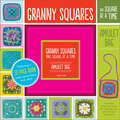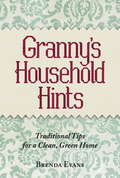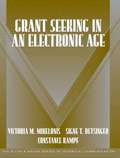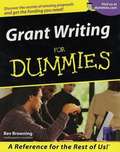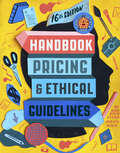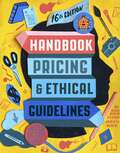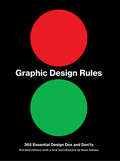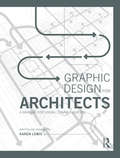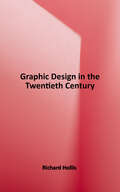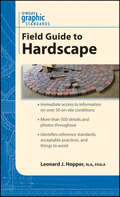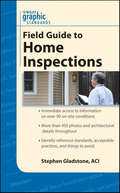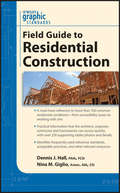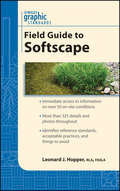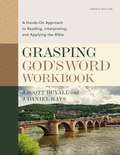- Table View
- List View
Grammar for Smart People
by Barry TarshisGood grammar is essential for effective communication. Yet many of us are plagued by the same nagging question: If I'm so smart why does grammar make me feel so dumb? Grammar For Smart People can help. Here at last, is a lively, user-friendly guide that zeroes in on the areas that give everyone the most trouble, and it does it with an advantage most grammar books lack - a light touch. You won't feel as though you're back in the fifth grade, diagramming sentences and struggling with a grammar textbook filled with dull, unbreakable rules.
Grammar for Smart People
by TarshisGood grammar is essential for effective communication. Yet many of us are plagued by the same nagging question: If I'm so smart why does grammar make me feel so dumb? Grammar For Smart People can help. Here at last, is a lively, user-friendly guide that zeroes in on the areas that give everyone the most trouble, and it does it with an advantage most grammar books lack - a light touch. You won't feel as though you're back in the fifth grade, diagramming sentences and struggling with a grammar textbook filled with dull, unbreakable rules.
Grammatically Correct: An Essential Guide to Punctuation, Style, Usage and More
by Anne StilmanHow does good writing stand out? If its purpose is to convey facts, findings, or instructions, it need be read only once for its content to be clear. If its purpose is to entertain or to provoke thought, it makes readers want to come back for more.Revised and updated, this guide covers four essential aspects of good writing:Individual words: spelling variations, hyphenation, frequently confused homonyms, frequently misused words and phrases, irregular plurals and negatives, and uses of capitalization and type style to add special meanings. Punctuation: the role of each mark in achieving clarity and affecting tone, and demonstration of how misuses can lead to ambiguity. Syntax and structure: agreement of subject and verb, parallel construction, modifiers, tenses, pronouns, active versus passive voice, and more. Style:advice on the less hard-and-fast areas of clarity and tone, including sentence length and order, conciseness, simplification, reading level, jargon and cliches, and subtlety. Filled with self-test exercises and whimsical literary quotations, Grammatically Correct steers clear of academic stuffiness, focusing instead on practical strategies and intuitive explanations. Discussions are designed to get to the heart of a concept and provide a sufficient sense of when and how to use it, along with examples that show what ambiguities or misinterpretations might result if the rules are not followed. In cases where there is more than one acceptable way to do something, the approach is not to prescribe one over another but simply to describe the options. Readers of this book will never break the rules of language again - unintentionally.
Gramática griega: Sintaxis del Nuevo Testamento - Segunda edición con apéndice (Biblioteca Teologica Vida)
by Daniel B. Wallace Daniel S. SteffenMuchos estudiantes de griego se frustran porque nunca aprenden cómo aplicar su conocimiento básico del griego a una interpretación del texto. Este libro ofrece un texto de referencia para los cursos de gramática griega del segundo año, y servirá de vínculo entere las formas de las palabras y sus diferentes usos dentro de contextos distintos. Estas diferencias casi siempre cambian el significado de la traducción e interpretación del teto griego del Nuevo Testamento.Este libro tan práctico:• Ayuda a conocer los contextos en que hay diferentes usos de las formas griegas.• Incluye muchos ejemplos del texto griego del Nuevo Testamento que sirve de modelo de cómo hacer exégesis.• Incluye ejercicios que permiten al estudiante aplicar la lista de usos de las categorías de sintaxis, después de aprenderlos.Este libro de sintaxis de la gramática griega es una adaptación y abreviatura del libro Greek Grammar Beyond the Basics: An Exegetical Syntax of the New Testament, que se usa en multitud de cursos de exégesis en muchos seminarios en inglés y otros idiomas del mundo. Este libro, por fin, cubre una necesidad en la enseñanza de la exégesis gramatical para todo el mundo que habla español.
Grand Entrance: Worship On Earth As In Heaven
by Edith M. HumphreyCan we understand worship in a way that transcends style, relevance, and aesthetics? Taking into account the most contested issues of the "worship wars," prominent New Testament scholar Edith Humphrey shows how the act of entering into God's presence is central to all true Christian worship. Regardless of worship style, when we come into God's presence, we praise God alongside angels and with the whole of creation. Seeking to reclaim the forgotten theme of worship as entry into God's presence, Humphrey shows its prominence in the Bible, providing an accessible but thorough study of the Old and New Testaments. She analyzes key moments in church history to show how worship developed in Eastern and Western churches. She also draws insights from healthy worshiping communities around the globe. The book offers practical guidance to worship directors, pastors, thoughtful lay readers, and students with regards to balanced and faithful worship.
Grandad's Wit and Wisdom: Quips and Quotes for Glorious Grandpas
by Richard BensonWhen your roses have been trampled by little feet and the golf has been hijacked by children’s TV, reach for this hilarious book, crammed full of quips and quotes to remind you why being a grandad is one of the best jobs in the world.
Grandad's Wit and Wisdom: Quips and Quotes for Glorious Grandpas
by Richard BensonWhen your roses have been trampled by little feet and the golf has been hijacked by children’s TV, reach for this hilarious book, crammed full of quips and quotes to remind you why being a grandad is one of the best jobs in the world.
Grandiloquent Words: A Pictoric Lexicon of Ostrobogulous Locutions
by Jason Travis OttThis recondite caboodle of glosses panegyrizes the boggles of our palaver.* Words confirm and deny, guarantee and deceive, elucidate and obfuscate. The more words you know, the better you can express yourself and the more you can do in life. The founder of Grandiloquent Word of the Day accordingly presents a voluptuary of verbiage encompassing rare and obscure terms that confound or delight, antiquated argot from myriad epochs, and lexemes for venturesome bibliophiles. Featuring a short, insightful introduction, Grandiloquent Words offers more than 250 preternatural terminologies for you to ingurgitate and brandish with aplomb for countless occasions. Bask in cataracts of mundane morphemes, bookish locutions, beef-witted blatteroons, corporeal catastrophes, playful patois, and jolly jubilations. These always-extra expressions encompass timeless topics and modern phenomena, painting a group portrait of our foibles and joys. Replete with pronunciations, etymologies, examples, and whimsical illustrations, it will edify and entertain. *This rare collection of definitions celebrates the marvels of our language.
Grandma's Wit and Wisdom: Quips and Quotes for the Greatest Grannies
by Richard BensonWhen there are sticky handprints on the sofa and you can’t prise the darlings away from a screen, reach into your handbag for this hilarious book, crammed full of quips and quotes to remind you why being a grandma is one of the best jobs in the world.
Grandma's Wit and Wisdom: Quips and Quotes for the Greatest Grannies
by Richard BensonWhen there are sticky handprints on the sofa and you can’t prise the darlings away from a screen, reach into your handbag for this hilarious book, crammed full of quips and quotes to remind you why being a grandma is one of the best jobs in the world.
Grandma's sayings... commented: Spanish sayings (libro 1 #1)
by Víctor Fernández CastillejoMuch of my education I have acquired from my maternal grandmother: María Cristina Barrón. Among her teachings you always found a saying tailor-made for what occasion. Over the years I have learned sayings from other people; in most cases, elderly women. This book is intended to be a tribute to all of them and to the millions of women who have endured popular wisdom through the years through sayings. It is also a way to spread Spanish through the proverbs. It is not intended to be just another book of sayings, since not all of them are —not even close— but they are all of them. The idea is to present some of the most popular sayings and comment on them from the humild and opinion of the writer. The other intention of the work is that the sayings of these women endure over the years and do not fall into oblivion. It is not a book —nor does it claim to be— that you consider your own, since many of the sayings are anonymous. It is a rec nowledge and pay for that s grandmothers who both offered their teachings and complained so little. To all of them: thank you, a thousand thanks.
Granny Squares, One Square at a Time: Amulet Bag
by Creative Publishing international“Crocheters looking to move beyond basic granny squares, as well as new crocheters drawn to these traditional motifs, will enjoy this collection.” —Library JournalWith all you need to start crocheting your very own granny squares, this kit includes a step-by-step, thirty-two–page booklet that contains illustrated instructions for crocheting classic granny squares, plus eight more granny square patterns. You’ll also get a special project that will help you create amulet bags made from your granny squares!
Granny's Household Hints: Traditional Tips for a Clean, Green Home
by Brenda EvansIn Granny's day there were few labour-saving devices or fancy cleaning products. So when it comes to getting stains out of the carpet or keeping her laundry sparkling white, she still prefers tried-and-tested techniques handed down through the generations. Many people nowadays would prefer to use natural, traditional cleaning methods, rather than chemicals that can be harmful to our health and the environment. So why not follow in Granny's footsteps and try her effective, green and surprisingly simple household hints? Learn how to keep your home spotless using common ingredients found in your kitchen cupboard, like lemon juice or bicarbonate of soda. You'll be helping the planet and your wallet too ... Granny would be proud!
Grant Seeking in an Electronic Age (Technical Communication Ser.)
by Victoria M. Mikelonis Signe T. Betsinger Constance KampfThis guide teaches students and professionals a systematic process for researching, designing, writing, and submitting successful grant-seeking proposals. <P><P>Focusing on proposals submitted for government, foundation, and corporation funding, Grant Seeking in an Electronic Age leads the reader through a six-step grant-seeking process, from researching potential funders, to designing, writing and submitting a proposal that follows the funder's guidelines. Grounded in theory, but rooted in successful practice, it teaches students what really works–a third of students who submit proposals based on this text's approach get funded within a year. The text's guided discovery process provides a useful framework for novice writers while its thinking-planning exercises offer useful ways of organizing information and discovering what still need to be researched.
Grant Writing for Dummies
by Bev BrowningGet the scoop on government grants, make multiple grant requests, use words that make funders say 'yes', recycle rejected proposals, and more!
Graphic Artists Guild Handbook, 16th Edition: Pricing & Ethical Guidelines
by The Graphic Artists GuildThe industry bible for communication design and illustration professionals, with updated information, listings, and pricing guidelines.Graphic Artists Guild Handbook is the industry bible for communication design and illustration professionals. A comprehensive reference guide, the Handbook helps graphic artists navigate the world of pricing, collecting payment, and protecting their creative work, with essential advice for growing a freelance business to create a sustainable and rewarding livelihood. This sixteenth edition provides excellent, up-to-date guidance, incorporating new information, listings, and pricing guidelines. It offers graphic artists practical tips on how to negotiate the best deals, price their services accurately, and create contracts that protect their rights. Sample contracts and other documents are included. For the sixteenth edition, the content has been reorganized, topics have been expanded, and new chapters have been added to create a resource that is more relevant to how graphic artists work today. Features include:More in-depth information for the self-employed on how to price work to make a sustainable living and plan for times of economic uncertainty.A new chapter on using skills and talents to maximize income with multiple revenue streams—workshops, videos, niche markets, passion projects, selling art, and much more.Current U.S. salary information and freelance rates by discipline.Pricing guidelines for buyers and sellers.Up-to-date copyright registration information.Model contracts and forms to adapt to your specific needs.Interviews with eleven self-employed graphic artists who have created successful careers,using many of the practices found in this Handbook.
Graphic Artists Guild Handbook: Pricing and Ethical Guidelines
by The Graphic Artists GuildThe industry bible for communication design and illustration professionals, with updated information, listings, and pricing guidelines. <p><p> Graphic Artists Guild Handbook is the industry bible for communication design and illustration professionals. A comprehensive reference guide, the Handbook helps graphic artists navigate the world of pricing, collecting payment, and protecting their creative work, with essential advice for growing a freelance business to create a sustainable and rewarding livelihood. <p><p> This sixteenth edition provides excellent, up-to-date guidance, incorporating new information, listings, and pricing guidelines. It offers graphic artists practical tips on how to negotiate the best deals, price their services accurately, and create contracts that protect their rights. Sample contracts and other documents are included. <p><p> For the sixteenth edition, the content has been reorganized, topics have been expanded, and new chapters have been added to create a resource that is more relevant to how graphic artists work today. <p><p> Features include: <p>• More in-depth information for the self-employed on how to price work to make a sustainable living and plan for times of economic uncertainty. <p>• A new chapter on using skills and talents to maximize income with multiple revenue streams—workshops, videos, niche markets, passion projects, selling art, and much more. <p>• Current U.S. salary information and freelance rates by discipline. <p>• Pricing guidelines for buyers and sellers. <p>• Up-to-date copyright registration information. <p>• Model contracts and forms to adapt to your specific needs. <p>• Interviews with eleven self-employed graphic artists who have created successful careers, using many of the practices found in this Handbook.
Graphic Design Rules: 365 Essential Design Dos and Don'ts
by Tony Seddon Sean Adams Peter Dawson John FosterDON'T use comic sans (except ironically!) but DO worship the classic typefaces like Helvetica and Garamond. Graphic Design Rules is a handy guide for professional graphic designers, students, and laymen who incorporate graphic design into their job or small business. Packed with practical advice, this spirited collection of design dos and don'ts takes readers through 365 rules like knowing when to use a modular grid—and when to throw the grid out the window. All designers will appreciate tips and lessons from these highly accomplished authors, who draw on years of experience to help you create good design.
Graphic Design for Architects: A Manual for Visual Communication
by Karen LewisGraphic Design for Architects is a handbook of techniques, explanations and examples of graphic design most relevant to architects. The book covers a variety of scales of graphic design, everything from portfolio design and competition boards, to signage and building super-graphics – to address every phase of architectural production. This book combines and expands on information typically found in graphic design, information design, and architectural graphics books. As architectural communication increases to include more territory and components of a project, it is important for designers to be knowledgeable about the various ways in which to communicate visually. For instance, signage should be designed as part of the process – not something added at the end of a project; and the portfolio is a manifestation of how the designer works, not just an application to sell a design sensibility. In thinking about architecture as a systematic and visual project, the graphic design techniques outlined in this book will help architects process, organize and structure their work through the lens of visual communication. Each chapter is titled and organized by common architectural modes of communication and production. The chapters speak to architects by directly addressing projects and topics relevant to their work, while the information inside each chapter presents graphic design methods to achieve the architects’ work. In this way, readers don’t have to search through graphic design books to figure out what’s relevant to them – this book provides a complete reference of graphic techniques and methods most useful to architects in getting their work done.
Graphic Design in the Twentieth Century: A Concise History (World of Art)
by Richard HollisA new edition of a seminal book on the history of graphic design in the twentieth century by one of the leading authorities in the field. The story of graphic design is one of the most exciting and important developments in twentieth-century visual culture. From its roots in the expansion of printing, graphic design has evolved from a means of identification, information, and promotion to a profession and art in its own right. This authoritative documentary history begins with the poster and goes on to chart the use of text and image in brochures and magazines, advertising, corporate identity, television, and electronic media, and includes the effects of technical innovations such as photography and the computer, as well as the digital revolution. With over eight hundred illustrations fully integrated with the text, this indispensable account is uniquely clear, comprehensive, and absorbing. For this latest edition, Graphic Design in the Twentieth Century has been updated with a new preface and additions to the bibliography, ensuring its continued usefulness to students and designers alike.
Graphic Standards Field Guide to Hardscape
by Leonard J. HopperQuick, reliable answers to your most common on-site questionsWhen you're in the field, you never know what you'll come across. The Graphic Standards Field Guide to Hardscape gives you fast access to the practical information you need when you're on-site and under pressure.Presented in a highly visual and easily portable format, the Field Guide is organized to follow a logical project sequence from site evaluation of existing conditions through construction maintenance. Covering everything from assessing existing conditions, site work, bases and paving, site improvements, and materials, this handy companion conveys the most common answers that landscape architects need in the real world when visiting a construction site, and meeting with architects and engineers or clients and contractors.The Field Guide to Hardscape extends the familiar Landscape Architectural Graphic Standards beyond the office or studio with:Quick access to essential information when away from the studioThings to look for when assessing existing conditions during preliminary design site visits or pre-construction meetingsGraphic Standards--quality details accompanied by real-world photographs of best construction practices and techniquesIllustrations that help you troubleshoot problems, along with on-the-spot solutionsA list of common construction mistakes and problems to avoidCompact format that's easy to reference and carry alongThe Graphic Standards Field Guide to Hardscape is the ideal companion for the on-the-go landscape architect, design professional, inspector, facilities manager or anyone that is involved with site construction.
Graphic Standards Field Guide to Home Inspections
by Stephen GladstoneQuick, reliable answers to your most common on-site questionsWhen you're in the field, you never know what you'll come across. The Wiley Graphic Standards Field Guide to Home Inspections gives you fast access to the information you need when you're on-site and under pressure.Presented in a highly visual and easily portable format, the Graphic Standards Field Guide to Home Inspections is organized according to CSI's Masterformat standards of practice. It covers everything from inspection preparation to on-site safety, conveying the most common answers with practical instruction about home inspections that the professional inspector, architect, engineer, or contractor needs to access quickly out in the field to evaluate an existing residential property.The Field Guide to Home Inspections extends the Graphic Standards experience outside of the office and into the field, with:Quick access to essential information wherever you areGraphic Standards-quality details accompanied by real-world photographs of the common conditions you'll find in residential buildingsIllustrations that help you troubleshoot problems, along with on-the-spot solutionsCompact format that's easy to reference and carry alongThe Graphic Standards Field Guide to Home Inspections is the ideal companion for the on-the-go professional home inspector.
Graphic Standards Field Guide to Residential Construction
by Dennis J. HallA must-have reference to more than 100 common residential conditions-from accessibility issues to working with zinc Practical information that the architect, engineer, contractor and homeowner can access quickly, with over 230 supporting tables photos and details Identifies frequently used reference standards, acceptable practices, and other relevant resources Quick, reliable answers to your most common on-site questions When you're in the field, you never know what you'll come across. Graphic Standards Field Guide to Residential Construction gives you fast access to the information you need when you're on-site and under pressure. Presented in a highly visual and easily portable format, Graphic Standards Field Guide to Residential Construction is organized by CSI's MasterFormat and is coordinated with the 2009 International Residential Code, as well as current sustainable practices. It addresses issues pertaining to residential construction by covering every aspect of the process, such as the use of materials, structural concerns, finishes, thermal and moisture protection, accessible design applications, and more. Graphic Standards Field Guide to Residential Construction extends beyond the studio, with: Quick access to essential information wherever you are Graphic Standards-quality details accompanied by photographs and tables Illustrations that help you troubleshoot problems, along with on-the-spot solutions Compact format that's easy to reference and carry along Graphic Standards Field Guide to Residential Construction is a handy companion that offers the essential tools that time-crunched professionals can turn to in an instant when dealing with clients, or when handling the many complex demands surrounding construction management.
Graphic Standards Field Guide to Softscape
by Leonard J. HopperQuick, reliable answers to your most common on-site questions When you're in the field, you never know what you'll come across. The Wiley Graphic Standards Field Guide to Softscape gives you fast access to the practical information you need when you're on-site and under pressure. Presented in a highly visual and easily portable format, the Field Guide is organized to follow a logical project sequence from site evaluation of existing conditions through construction maintenance. Covering everything from soils and planting to storm water drainage, this handy companion conveys the most common answers that landscape architects addressing issues pertaining to softscape need when visiting construction sites and meeting with architects, engineers, clients, or contractors. The Field Guide to Softscape extends the familiar Landscape Architectural Graphic Standards beyond the office, with: Quick access to essential information when away from the studio Things to look for when assessing existing conditions during preliminary design site visits or pre-construction meetings Graphic Standards-quality details accompanied by real-world photographs of best construction practices and techniques Illustrations and real-world photographs that help you troubleshoot problems, along with on-the-spot solutions A list of common construction mistakes and problems to avoid Compact format that's easy to reference and carry along to job sites The Graphic Standards Field Guide to Softscape is the ideal companion for the on-the-go landscape architect, design professional, inspector, facilities manager, or anyone who is involved with site construction. Immediate access to information on over 50 on-site conditions More than 325 details and photos throughout Identifies reference standards, acceptable practices, and things to avoid
Grasping God's Word Workbook, Fourth Edition: A Hands-On Approach to Reading, Interpreting, and Applying the Bible
by J. Daniel Hays J. Scott DuvallA Companion WORKBOOK to Today's Most Widely Used Textbook for Learning to Interpret and Understand the BibleGrasping God's Word has proven itself in classrooms across the country as an invaluable help to students who want to learn how to read, interpret, and apply the Bible for themselves. This WORKBOOK is designed for use alongside the fourth edition of the textbook Grasping God's Word. While the textbook shows you the principles and tools of interpretation, the WORKBOOK lets you try them out by applying them to specific genres and contexts. Together, these books will help you get a grip on the solid rock of Scripture--how to read it, how to interpret it, and how to apply it.Filling the gap between approaches that are too simple and others that are too technical, this book starts by equipping readers with general principles of interpretation, then moves on to apply those principles to specific genres and contexts. Features include:Proven in classrooms across the countryHands-on exercises to guide students through the interpretation processEmphasis on real-life applicationSupplemented by a website for professors providing extensive teaching materialsUpdates corresponding to the fourth edition of the textbook, including new exercisesAccompanying textbook, video lectures, laminated study guide (sold separately)When used alongside the textbook, this workbook is the ideal resource for anyone looking for a hands-on step-by-step guide that will teach them how to accurately and faithfully interpret the Bible.
